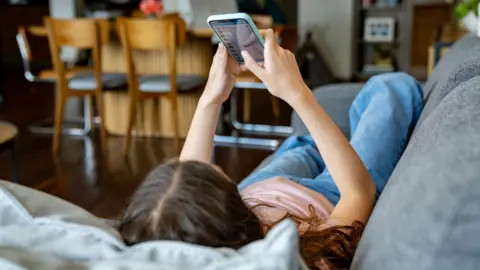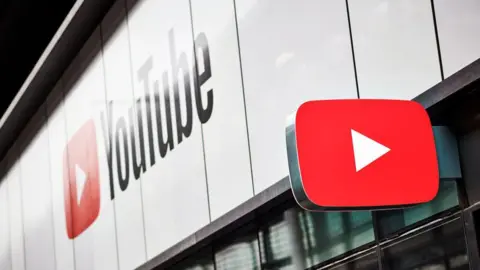Australia’s social media ban for kids under 16 – how will it work?
November 20, 2025
Australia is banning social media for kids under 16. How will it work?
 Getty Images
Getty ImagesFrom 10 December, social media companies will have to take “reasonable steps” to ensure that under-16s in Australia cannot set up accounts on their platforms and that existing accounts are deactivated or removed.
The government says the ban – a world-first policy popular with many parents – is aimed at reducing the “pressures and risks” children can be exposed to on social media, which come from “design features that encourage them to spend more time on screens, while also serving up content that can harm their health and wellbeing”.
A study commissioned by the government earlier this year said 96% of children aged 10-15 used social media and that seven out of 10 of them had been exposed to harmful content and behaviour. This behaviour ranged from misogynistic material to fight videos and content promoting eating disorders and suicide.
One in seven also reported experiencing grooming-type behaviour from adults or older children, and more than half said they had been the victims of cyberbullying.
What platforms are affected?
The Australian government has so far named nine platforms to be included in the ban: Facebook, Instagram, Snapchat, Threads, TikTok, X, YouTube, Reddit and only streaming platform Kick.
It is also under pressure to expand the ban to online gaming. Fearing they may be targeted, gaming platforms such as Roblox and Discord have recently introduced age checks on some features in an apparent bid to ward off inclusion in the ban.
The government has said it will continue to review the list of affected platforms, and will consider three main criteria when doing so.
These comprise whether the platform’s sole or “significant purpose” is to enable online social interaction between two or more users; whether it allows users to interact with some or all other users; and whether it allows users to post material.
YouTube Kids, Google Classroom and WhatsApp are not included as they were not deemed to have met those criteria. Children will also still be available to view most content on platforms like YouTube, which do not require an account.
How will the ban be enforced?
Children and parents will not be punished for infringing the ban – it is social media companies who are charged with enforcing it, and they face fines of up to $49.5m (US$32m, £25m) for serious or repeated breaches.
The government says these companies must take “reasonable steps” to keep kids off their platforms, and use age assurance technologies – without specifying which ones.
Several possibilities have been raised, including the use of government IDs, face or voice recognition and age inference. The latter of these uses online information other than a date of birth – such as online behaviour or interactions – to estimate a person’s age.
 Getty Images
Getty ImagesThe government is encouraging platforms to use multiple different methods. It has also said platforms cannot rely on users declaring their own age, or on parents vouching for their children.
Meta, which owns Facebook, Instagram and Threads, has announced it will begin closing teen accounts from 4 December. Those mistakenly kicked off could use a government ID or provide a video selfie to verify their age, the company said.
The other affected platforms have not yet said how they will comply with the ban.
Will it work?
Without a clear idea of what methods companies will be using, it’s hard to say whether the social media ban will be effective – but concerns have been raised that age assurance technologies may wrongly block some users while failing to spot others who are underage.
The government’s own report found that facial assessment technology, for example, is least reliable for the exact demographic it’s needed to target.
Questions have also been raised as to whether the fines for infringement are big enough. As former Facebook executive Stephen Scheeler told AAP: “It takes Meta about an hour and 52 minutes to make $50 million in revenue”.
Critics argue that the ban, even if properly implemented, will not actually reduce online harm for children. Dating websites and gaming platforms are not included, and nor are AI chatbots, which have recently made headlines for allegedly encouraging children to commit suicide and for having “sensual” conversations with minors.
Others point out that teens who rely on social media for community will be left isolated, and argue that educating children about how to navigate social media would be more effective.
Communications Minister Annika Wells has conceded that the ban may not be “perfect”.
“It’s going to look a bit untidy on the way through,” she said in early November. “Big reforms always do.”
Are there data protection concerns?
Critics have also raised concerns about the large-scale collection and storage of data that will be required, and its potential mishandling, as platforms try to verify users’ ages.
Australia – like much of the world – has in recent years seen a series of high-profile data breaches, including several where sensitive personal information was stolen and sold or published.
But the government says the legislation incorporates “strong protections” for personal information. These protections stipulate that such information may not be used for anything other than age verification and must be destroyed once that has been done, with “serious penalties” for breaches.
It also says platforms must offer an alternative to the use of governments IDs for age assurance.
How have social media companies responded?
Social media companies were aghast at the announcement of the ban in November 2024. They argued it would be difficult to implement, easy to circumvent and time consuming for users, as well as posing risks to their privacy.
They also suggested it would drive children into dark corners of the internet and deprive young people of social contact. Snap – which owns Snapchat – and YouTube also denied being social media companies.
YouTube’s parent company, Google, is reportedly still considering whether to launch a legal challenge to the platform’s inclusion. It did not respond to a BBC request for comment.
 Getty Images
Getty ImagesEven as it announced that it would implement it early, Meta argued the ban would leave teens with “inconsistent protections across the many apps they use”.
At parliamentary hearings in October, TikTok and Snap said they still opposed the ban but would implement it.
Kick – the only Australian company included in the ban – has said it will introduce a “range of measures” and continue to engage “constructively” with authorities.
Do other countries have similar bans?
The ban on under-16s using social media is a world first, and other countries will be watching closely. Different approaches have been tried elsewhere to limit screen and social media time for children and keep them from accessing harmful material, but nowhere has put a total ban on the platforms involved.
In the UK, new safety rules introduced in July mean online companies face large fines or even the jailing of their executives if they fail to implement measures to protect young people from seeing illegal and harmful content.
Other European countries allow the use of social media under a certain age only with parental consent. In September, a French parliamentary enquiry recommended banning under-15s from social media, as well as a social media “curfew” for 15- to 18-year-olds.
Denmark has announced plans to ban social media for under-15s, while Norway is considering a similar proposal. Spain’s government has sent to parliament a draft law for under-16s to require their legal guardians to authorise access.
Meanwhile, an attempt in the US state of Utah to ban under-18s from social media without parental consent was blocked by a federal judge last year.
Will children try to get around the ban?
Teens interviewed by the BBC said they were opening new accounts with fake ages ahead of the ban – although the government has warned social media companies it expects them to detect such accounts and remove them.
Online, teenagers are also recommending alternative social media apps or giving tips they hope will help them bypass the ban.
Some teens, including influencers, have switched to joint accounts with their parents. Commentators are also predicting a surge in the use of VPNs – which hide the country a person is accessing the internet from – as happened in the UK after the implementation of age control rules.
Search
RECENT PRESS RELEASES
Related Post


